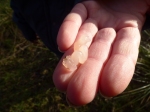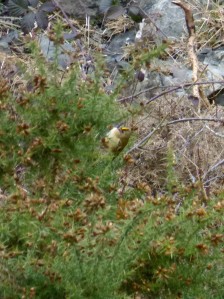We Knew We Had Been There Before
Part of me feels I should start splitting my blog posts into four sections – Chesil Beach, Lorton Meadows, the garden and adventures out and about. Thoughts on that idea welcome, but for now, let’s get on with looking at wildlife!
Wait hang on, wildlife is suffering for oh so many reasons, and I want to highlight one of them briefly – litter. Isn’t it just awful?! Cans with the last remnants of fizzy drinks, dirty plastic bottles, torn and mangled plastic bags hanging from trees or caught up in grass. You’re probably nodding as you read this, we all see litter all the time. But how often do you actually do something about it? If you’re my dad (unlikely as I don’t think he reads this blog often), that’s quite often. Rarely a dog walk goes by when he doesn’t pick up some litter and put it in the bin. The rest of you though? Have an honest think for a moment … how often do you walk past litter? Or watch someone drop litter and say nothing? Or (hopefully not!) drop litter yourself because (a) it’s just a little bit, so it doesn’t matter, (b) there are no bins around and no way are you putting it in your pocket / bag, or (b) you’re in car so it’s fine to chuck it out the window? And that’s just litter … don’t get me started about dog mess!
Why am I going on about litter? Well, first it is one of my 2015 Wildlife Resolutions to pick up more litter which I have been trying to do, and second I took a photo of one of my quick litter picks on Monday to put onto Twitter under the hashtag of #2minutebeachclean. It’s a wonderful idea, literally just spend two minutes picking up litter whilst you’re at the beach (obviously don’t add any litter to the beach during your visit!). Imagine if all the visitors did that … *dreams happily of litter-free beaches*.
Why bother though? Well! As previously mentioned, litter is awful for wildlife. It gets eaten and kills a variety of animals – including beautiful albatrosses and turtles. Even degraded plastic is not safe – it turns into microplastics and ends up in the food chain (and likely in your seafood)! Plus, litter is an eyesore, and by picking it up, perhaps you’ll inspire others to pick up litter too and soon your local area will be litter-free! Hooray!
So next time you’re out and about, do pick up some litter!
Ok, now back to wildlife. Whilst litter picking, I could see some Terns about on the Fleet. I’m still not 100% sure I have seen a Little Tern (Sternula albifrons), so won’t tick that species off for 2015 just yet. However, there were plenty of Sandwich Terns (Sterna sandvicensis) diving for food. I also managed to take a rather blurry photo of Red-breasted Merganser (Mergus serrator). Another aim for my time here – get some better photos of that species?
I also spent time over at Lorton Meadows as expected, trying to learn a bit more about the reserve – both its history and wildlife. There’s a wonderful variety of wildflowers and insects (as well as birds of course – oh, if you don’t know of the Kestrel Webcam, go watch! I warn you though, it’s quite addictive!), and I’m looking forward to seeing how it all changes across the seasons. Fingers crossed, I’ll be allowed to do some moth trapping there as well!
I won’t keep you much longer, I just want to show off a couple of the moths that I caught in the garden this week – before it started raining at the end of the week. My catches included a particular beauty called the Early Thorn (Selenia dentaria) whose wing patterning is beautiful I think. I tweeted about this species early in the week, and it seems that others agree with my thoughts, which is marvellous (though not unexpected).

















































































